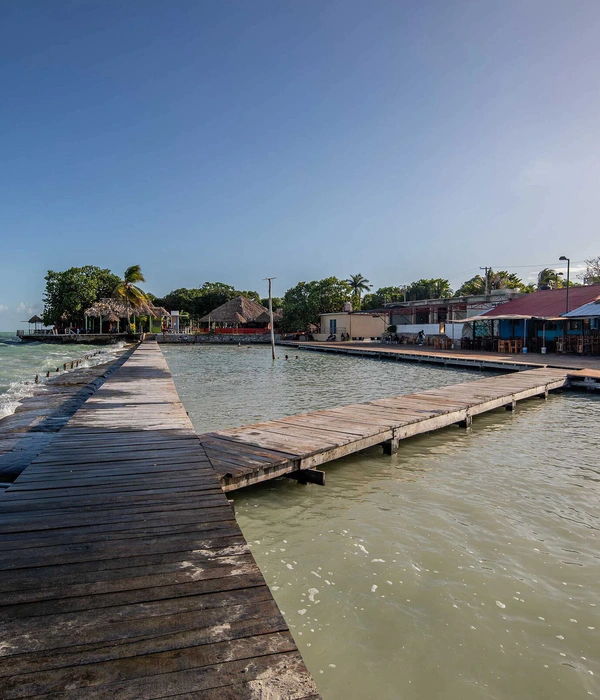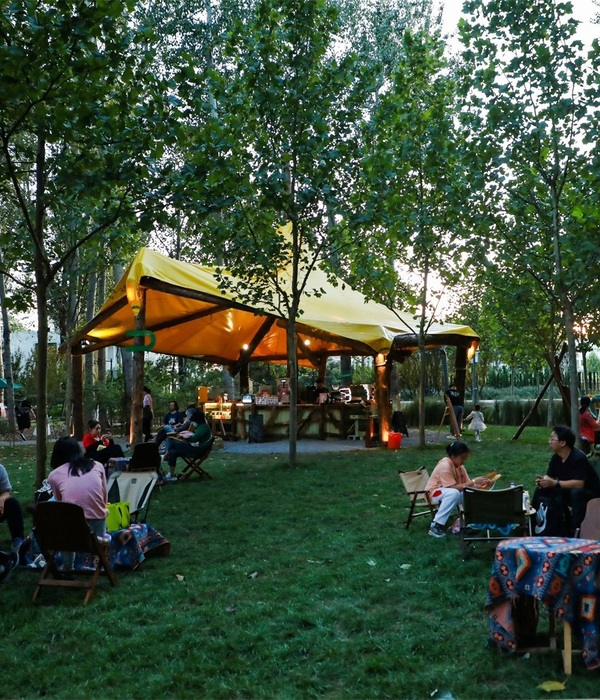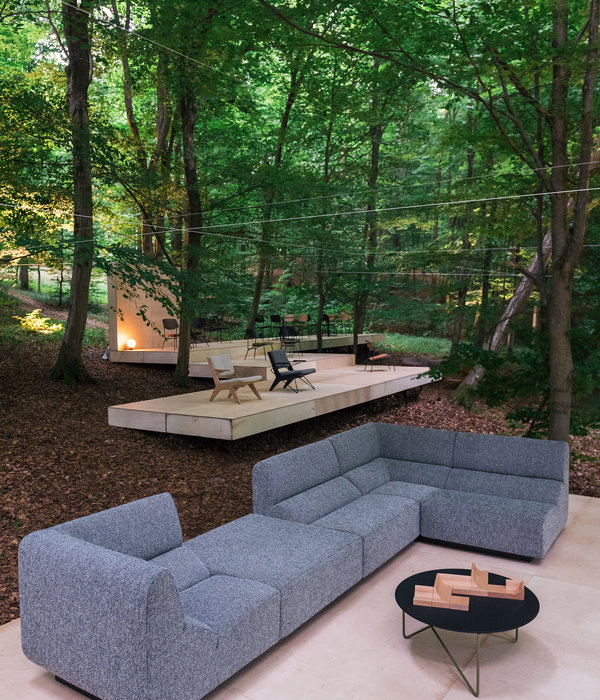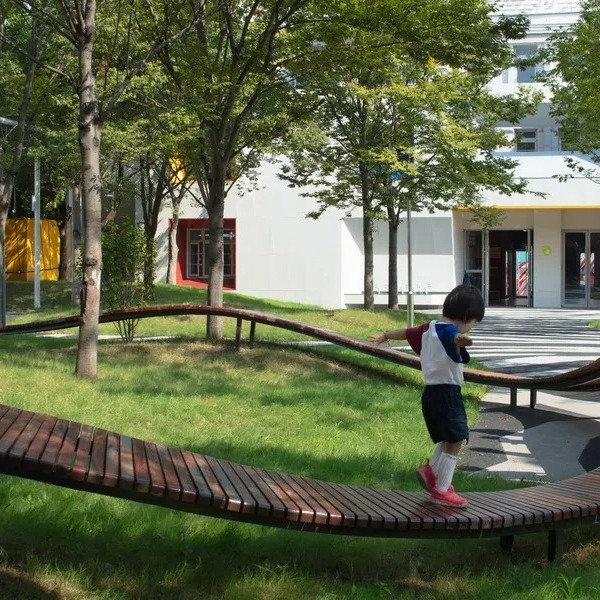Little Island是一个新修的公园,承载着哈德逊河上的3个表演场所。它是一个可供人与野生动物栖息的乐园、一片葱郁的绿洲,并通过雕塑般的花槽被支撑在水面上。借助步桥,从这里到曼哈顿下西区只需步行一段很短的距离。
Little Island is a new public park that shelters three new performance venues on the Hudson River. Designed as a haven for people and wildlife, it is a green oasis, held above the water by sculptural planters, and located just a short walk across a gangplank from Manhattan’s Lower West Side.
▼项目概览,preview © Michael Grimm Photography
Heatherwick Studio最初是在慈善家Barry Diller与哈德逊河公园信托公司的邀请下为曼哈顿西南边的新码头设计一座公共场馆。不过项目团队并没有选择简单地设计一座装饰性的建筑,而是从中看到了重新思考和定义码头的机会。设计的出发点并非结构,而是游客所能获得的体验:漫步于水面之上的兴奋感,以及远离城市并沉浸在绿色中的惬意——这一想法是受到中央公园的启发而产生的,在那里人们会忘却自己正身处美国人口最稠密的城市当中。
▼公园平面图,general park plan © Heatherwick Studio and MNLA
Heatherwick Studio was initially invited by philanthropist Barry Diller and the Hudson River Park Trust to create a pavilion for a new pier off the south-west of Manhattan. Instead of designing a decorative object to sit in the Hudson River Park, the design team saw an opportunity to rethink what a pier could be. The starting point was not the structure, but the experience for visitors: the excitement of being over the water, the feeling of leaving the city behind and being immersed in greenery – inspired by Central Park, where it’s possible to forget that you are in the midst of the most densely populated city in the United States.
▼鸟瞰,aerial view © Timothy Schenck
▼哈德逊河上的小岛公园,Little Island above the Hudson River © Timothy Schenck
码头通常是平坦的,以方便船只停靠。但它们是不是必须如此呢?相较于曼哈顿平坦的街道,设计团队希望为城市创造一种新的地形,使其可以向上抬升以塑造多样的空间。最初的方案是一片漂浮在水面上的卷曲树叶,它的叶脉像骨骼一般在边缘处抬升,为空间提供庇护。将公园抬升于基座的想法来源于水中既有的木桩,它们是过去从曼哈顿海岸线延伸出来的众多码头的遗留物。在裸露出来的尖顶之下,这些基柱已成为海洋生物的重要栖息地,亦是鱼类的保护和繁殖地。
▼地形剖面图,geological section © Heatherwick Studio and MNLA
Piers were traditionally flat to allow boats to dock, but did they have to be? In contrast to the flat streets of Manhattan, the design team wanted to create a new topography for the city, which could rise up to shape a variety of spaces. The first iteration was a curled leaf form floating on the water, its veins rising like ribs at the edges to shelter the space from the wind. The idea of raising the park on its foundations came from the existing wooden piles in the water, remnants of the many piers that used to extend from the shoreline of Manhattan. Beneath the visible tips of the wood, the piles have become an important habitat for marine life and are a protected breeding ground for fish.
▼岛上最高点,highest point © Timothy Schenck
Heatherwick Studio将码头构想为一场完整的体验:一个富有凝聚力的单体构筑物,而不是将不相关的元素叠加在一起。对于任何类型的码头,利用新的基柱来提供支撑都是十分必要的。这些基柱不再只是用于支撑甲板的细长物,而是成为了甲板本身——它们延伸至花槽并与之融为一体,共同构成了公园的表面。
Heatherwick Studio envisaged the pier as a complete experience; a single, cohesive object, rather than unrelated elements stuck together. New piles would be necessary to support any type of pier. Instead of sticks holding up a deck, the piles become the deck – they extend into planters that join together to create the park’s surface.
▼基柱与花槽融为一体,共同构成了公园的表面 © Timothy Schenck The piles extend into planters that join together to create the park’s surface
▼从休闲步道望向公园,Little Island from the esplanade © Timothy Schenck
变化的基柱高度定义出公园的轮廓:码头的一角被抬起,使阳光能够照射到下方的海洋栖息地;边缘的部分逐渐下降,形成一系列山丘和观景台,同时开辟出一个天然的露天剧场,用于举行表演活动。以这种方式,码头与它的支撑结构形成了统一的整体。
The height of the piles varies to create the park’s contours: the corner of the pier is lifted to allow sunlight to reach the marine habitat, and the edge falls to define hills, viewpoints and to carve out a natural amphitheatre for performances. In this way, the pier and its supporting structure are one.
▼起伏的轮廓,the contours of the park © Timothy Schenck
▼露天剧场,the amphitheatre © Timothy Schenck
▼“郁金香桥”,’Tulip Bridge’ © Timothy Schenck
这些花槽,或者说“花盆”,其内部充满了一百多种本地树木和植物,能够在纽约的气候中茁壮生长,同时提高生物多样性——小岛的每个角落都代表着一种不同的微气候。
The planters, or ‘pots’ are filled with more than a hundred different species of indigenous trees and plants, which encourage biodiversity and are able to thrive in New York’s climate – each corner of the island represents a different microclimate.
▼小岛的每个角落都代表着一种不同的微气候,Each corner of the island represents a different microclimate © Timothy Schenck
▼活动场地,play ground © Timothy Schenck
▼休闲草坪,the recreation area © Timothy Schenck
为了确定花槽的形式,设计团队从大自然中汲取灵感,并借鉴了河流被冻住时在基柱周围形成的马赛克状的冰块。设计团队将其重新诠释为为一个嵌合式的图案,它看上去是有机且不规则的,但实际上是由可以标准化制造的单元重复组合而成。
▼花槽细部剖面 & 轴测分解图,detail pot section & exploded pot axon © Heatherwick Studio and MNLA
To determine the pots’ form, the design team looked to nature, and the mosaic of ice that forms around the wooden piles when the river freezes. The studio reinterpreted this in a tessellated pattern that appears organic, but uses repeated elements that could be standardised for fabrication.
▼花槽立面,the facade of the pots © Max Guliani from Hudson River Park
▼花槽外观,exterior view © Timothy Schenck
在小岛四周最为明显的位置,这些花槽的角度和重复方式经过了尤其细致的考量。为了让混凝土结构拥有光滑的触感,Heatherwick Studio与当地一家制造商进行了密切合作。预制构件通过船只被运送至场地进行组装,最大限度地减少了对城市的干扰。
Care was taken to vary the angle and repetition of pots at the perimeter, where they were most visible. To give the structural concrete a smooth, tactile quality, Heatherwick Studio worked closely with a local fabricator. The precast components were transported by boats and assembled on site, minimising disruption to the city.
▼从“郁金香桥”下方望向花槽,pots from below ‘Tulip Bridge’ Photo Credit Thomas Schenck © Little Island
▼全景鸟瞰,aerial view © Timothy Schenck
▼公园层平面图(秋季),general plan park level (autumn) © Heatherwick Studio and MNLA
▼局部平面图,enlarged plan © Heatherwick Studio and MNLA
▼剖面图A-A’,section A-A’ © Heatherwick Studio and MNLA
▼剖面图B-B’,section B-B’ © Heatherwick Studio and MNLA
Project Name: Little Island Location: New York, New York Completion date: May 2021 Area: 11,000 sqm Designed by Heatherwick Studio Design Director Thomas Heatherwick Group Leader: Mat Cash Project Leader: Paul Westwood, Neil Hubbard Technical Design Leader: Nick Ling Project team: Sofia Amodio, Simona Auteri, Mark Burrows, Jorge Xavier Méndez- Cáceres, John Cruwys, Antoine van Erp, Alex Flood, Michal Gryko, Ben Holmes, Ben Jacobs, Francis McCloskey, Stepan Martinovsky, Simon Ng, Wojtek Nowak, Giovanni Parodi, Enrique Pujana, Akari Takebayashi, Ondrej Tichý, Ahira Sanjeet, Charles Wu, Meera Yadave Making team: Jordan Bailiff, Einar Blixhavn, Darragh Casey, Hayley Henry, Hannah Parker, Luke Plumbley, Jeff Powers Client: Hudson River Park Trust (HRPT) & Pier 55 Project Fund (P55P) Main Contractor: Hunter Roberts Construction Group Structural Engineer: Arup Landscape Design: MNLA Executive Architects: Standard Architects Mechanical Engineering: Arup Marine Engineers: MRCE Cost Consultant: Gardiner & Theobald
{{item.text_origin}}












